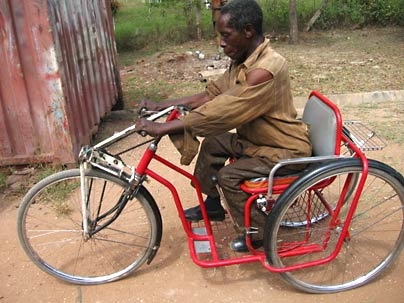A graduate student in mechanical engineering spent last summer assessing wheelchair technology and availability in a country where only 3 percent of those who need a wheelchair can get one.
In June 2005, Amos Winter traveled to Tanzania on a public service fellowship to gather information for the Tanzania Training Center for Orthopedic Technologies (TTCOT) in collaboration with San Francisco-based Whirlwind Wheelchair International.
"This is an area where I can make a real contribution," he said. During his time in Tanzania, Winter interviewed hundreds of wheelchair users about the challenges they face every day.
Most of the people he interviewed had been paralyzed as children, but had not received a wheelchair until they were in their 20s or 30s. Many had spent years strapping sandals on their hands and crawling on the ground to get around, Winter said.
For many, a wheelchair or the lack thereof was a major part of life, affecting employment, marriage status and more. "The wheelchair and the rest of their lives were completely intertwined," said Winter.
The problems Winter encountered were specific to the region, including the difficulties posed by the terrain, poverty, social stigma and the lack of knowledgeable wheelchair technicians. So, Winter said he tried to find solutions that would use what the region offered.
For example, after watching average Tanzanians pedal three-wheeled vehicles to and from work, Winter worked with local technicians to design a hand-crank to adapt them for use by the disabled. The system would allow wheelchair users to travel long distances without the fatigue associated with common wheelchairs, which are built for maneuverability rather than speed.
Local buses typically can't accommodate wheelchairs, so most who are disabled need to find their own way to work, Winter said. Up to 30 percent of Tanzanian wheelchair-users travel more than 5 kilometers (3.1 miles) over rocky and dusty terrain each day.
Getting a wheelchair repaired can also present daunting challenges in Tanzania, since many are imported and parts are expensive. Bicycles, in comparison, are plentiful and far less expensive, so Winter suggested using bicycle parts as replacement pieces. Over the life of a wheelchair, this small change could save the user up to $200.
Another problem Winter encountered was improperly fit wheelchairs. A poor fit can lead to pressure sores, which can become infected and painful. In some cases, the infections can even lead to death, said Winter. "That is a relatively simple change to make," said Winter. Fitting a wheelchair is a skill that can be taught at little cost.
One of Winter's goals is to educate those who manufacture wheelchairs in Tanzania. He plans to spend the summer working on a manual of basic mechanical engineering skills. This September, he will present the manual both to local technicians in Tanzania and at the 2006 African Wheelchair Congress.
Working with Amy Smith, an instructor in the Edgerton Center, Winter plans to run a public service design seminar in spring of 2007 in which students will build on the ideas he started in Tanzania. "I am looking for it to be collaborative," said Winter, who expects a large turnout. "It is a problem that is appealing to people."
Winter described his experience in Tanzania as life-changing. "This will continue to be a part of my future career," he said. "It was inspirational."
For more information, visit the MIT Public Service Center web site at web.mit.edu/mitpsc/.
A version of this article appeared in MIT Tech Talk on March 22, 2006 (download PDF).








